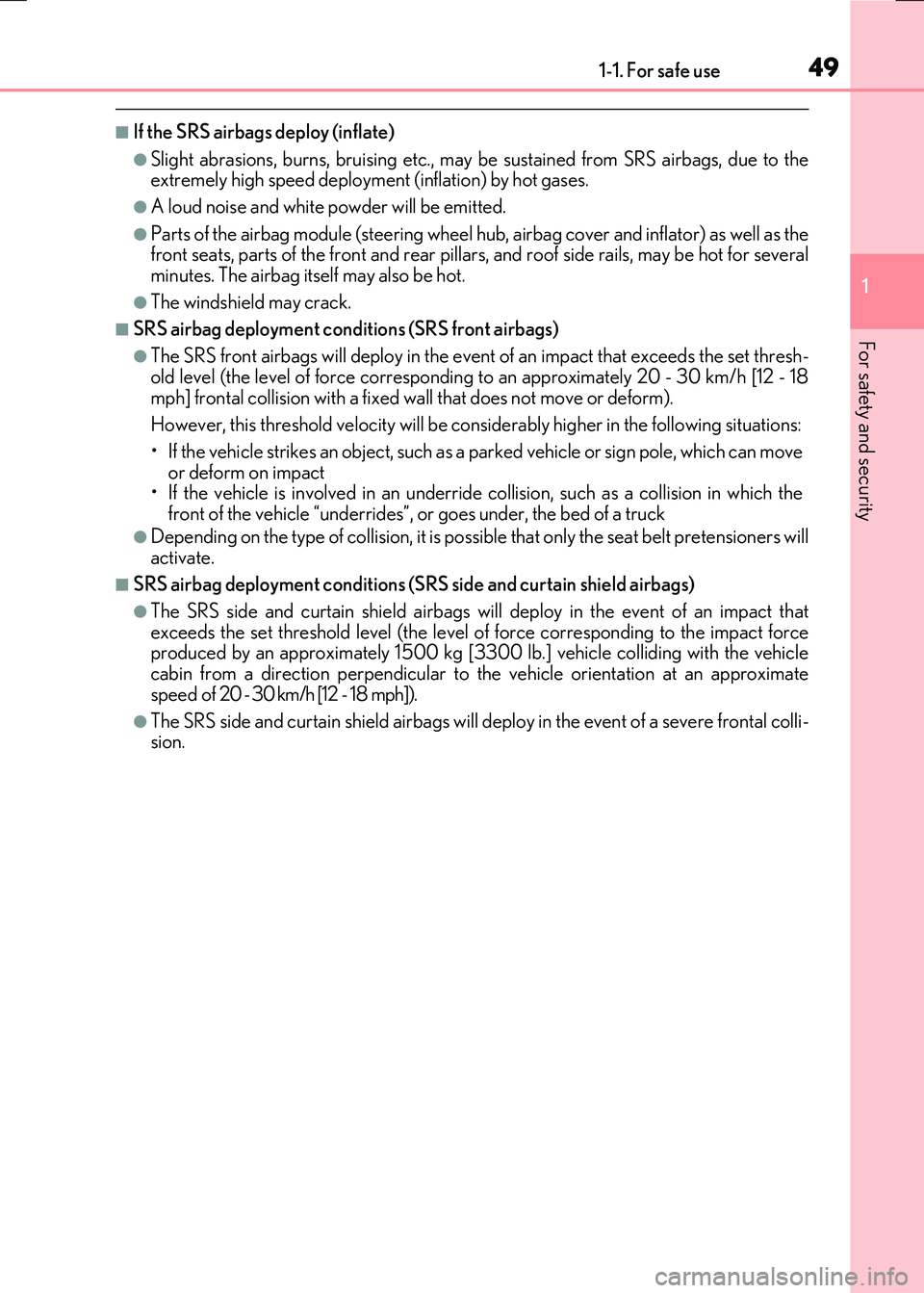Page 49 of 640

491-1. For safe use
1
For safety and security
RC300h_EE(OM24740E)
■If the SRS airbags deploy (inflate)
●Slight abrasions, burns, bruising etc., may be sustained from SRS airbags, due to the extremely high speed deployment (inflation) by hot gases.
●A loud noise and white powder will be emitted.
●Parts of the airbag module (steering wheel hub, airbag cover and inflator) as well as thefront seats, parts of the front and rear pillars , and roof side rails, may be hot for several minutes. The airbag itself may also be hot.
●The windshield may crack.
■SRS airbag deployment conditions (SRS front airbags)
●The SRS front airbags will deploy in the event of an impact that exceeds the set thresh-
old level (the level of force corresponding to an approximately 20 - 30 km/h [12 - 18 mph] frontal collision with a fixed wall that does not move or deform).
However, this threshold velocity will be cons iderably higher in the following situations:
• If the vehicle strikes an object, such as a parked vehicle or sign pole, which can move or deform on impact• If the vehicle is involved in an underride collision, such as a collision in which the
front of the vehicle “underrides”, or goes under, the bed of a truck
●Depending on the type of collision, it is possib le that only the seat belt pretensioners will
activate.
■SRS airbag deployment conditions (SRS side and curtain shield airbags)
●The SRS side and curtain shield airbags w ill deploy in the event of an impact that
exceeds the set threshold level (the level of force corresponding to the impact force produced by an approximately 1500 kg [3300 lb.] vehicle colliding with the vehiclecabin from a direction perpendicular to the vehicle orientation at an approximate
sp ee d o f 20 - 30 km/h [12 - 18 mph]).
●The SRS side and curtain shield airbags will de ploy in the event of a severe frontal colli- sion.
Page 249 of 640
249
4
Driving
RC300h_EE(OM24740E)
4-4. Refueling
●Close both side doors and windows, and turn the power switch off.
●Confirm the type of fuel.
■Fuel types
P. 606
■Fuel tank opening for unleaded gasoline
To help prevent incorrect fueling, your vehicle has a fuel tank opening that only accom-
modates the special nozzle on unleaded fuel pumps.
Opening the fuel tank cap
Perform the following steps to open the fuel tank cap:
Before refueling the vehicle
Page 598 of 640
5989-1. Specifications
RC300h_EE(OM24740E)
Engine
Model2AR-FSE
Type4-cylinder in line, 4-cycle, gasoline
Bore and stroke90.0 98.0 mm (3.54 3.86 in.)
Displacement2494 cm3 (152.2 cu. in.)
Valve clearanceAutomatic adjustment
Drive belt tensionAutomatic adjustment
Fuel
Fuel type
EU area: Unleaded gasoline conforming to European standard
EN228 only Except EU area: Unleaded gasoline only
Research Octane Number95 or higher
Fuel tank capacity
(Reference)66 L (17.4 gal., 14.5 Imp. gal.)
Electric motor (t raction motor)
TypePermanent magnet synchronous motor
Maximum output105 kW
Maximum torque300 N•m (30.6 kgf•m, 221.3 ft•lbf)
Hybrid battery (traction battery)
TypeNickel-Metal hydride battery
Voltage7.2 V/module
Capacity6.5 Ah (3HR)
Quantity32 modules
Overall voltage230.4 V
Page 640 of 640
640
RC300h_EE(OM24740E)
GAS STATION INFORMATION
Auxiliary catch leverTrunk openerFuel filler door
P. 471 P. 150 P. 249
Hood lock release leverTire inflation pressure
P. 471P. 604
Fuel tank capacity (Reference) 66 L (17.4 gal., 14.5 Imp. gal.)
Fuel type
EU area: Unleaded gasoline conforming to European
standard EN228 only Except EU area: Unleaded gasoline onlyP. 598, 606
Cold tire inflation
pressure P. 604
Engine oil capacity (Drain and refill — reference)
L (qt., Imp. qt.) With filter 4.5(4.8, 4.0)Without filter 4.1 (4.3, 3.6)
Engine oil type
“Toyota Genuine Motor Oil” or equivalent
Oil grade: 0W-20, 5W-30 and 10W-30:
API grade SL “Energy-Conserving”, SM “Energy- Conserving” or SN “Resource-Conserving”; or ILSACmultigrade engine oil
15W-40: API grade SL, SM or SN multigrade engine oilP. 599